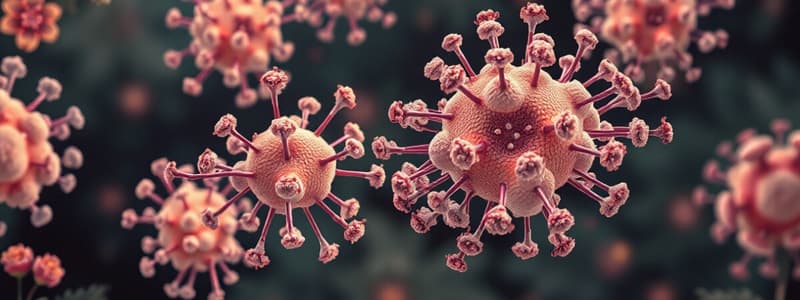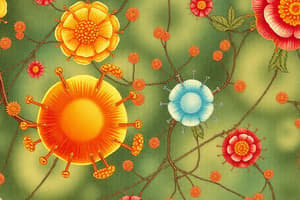Podcast
Questions and Answers
What is the primary role of Major Histocompatibility Complex (MHC) molecules in the immune system?
What is the primary role of Major Histocompatibility Complex (MHC) molecules in the immune system?
- To directly kill infected cells
- To serve as a memory for previous infections
- To produce antibodies in response to pathogens
- To display antigen peptides to T cells (correct)
Which of the following statements about MHC molecules is true?
Which of the following statements about MHC molecules is true?
- All types of cells express MHC II molecules
- MHC I is expressed by all nucleated cells (correct)
- MHC II can be found on resting T cells
- MHC molecules are only found in humans
What characteristic of MHC molecules contributes to individual diversity in immune responses?
What characteristic of MHC molecules contributes to individual diversity in immune responses?
- Their exclusive presence in all humans
- The absence of genes from both parents
- A uniform structure for all individuals
- Multiplicity of their alleles (correct)
What is true regarding peptide binding in MHC I molecules?
What is true regarding peptide binding in MHC I molecules?
How does MHC II differ from MHC I in terms of expression?
How does MHC II differ from MHC I in terms of expression?
What are the major loci for the human MHC class II gene complex?
What are the major loci for the human MHC class II gene complex?
What does the term 'amateur antigen presentation' refer to in relation to T cell activation?
What does the term 'amateur antigen presentation' refer to in relation to T cell activation?
Which types of peptides do MHC II molecules primarily present?
Which types of peptides do MHC II molecules primarily present?
What is the role of tapasin in the peptide-loading process of MHC I?
What is the role of tapasin in the peptide-loading process of MHC I?
What is the function of ERAP in the MHC I processing pathway?
What is the function of ERAP in the MHC I processing pathway?
Which chaperone binds to the monoglucosylated N-linked glycan in MHC I?
Which chaperone binds to the monoglucosylated N-linked glycan in MHC I?
How does the interaction between TAP and MHC I occur?
How does the interaction between TAP and MHC I occur?
What happens to MHC I after it binds to a peptide?
What happens to MHC I after it binds to a peptide?
What type of peptides does MHC I primarily bind?
What type of peptides does MHC I primarily bind?
What role do the alpha 1 and 2 domains of MHC I play during peptide binding?
What role do the alpha 1 and 2 domains of MHC I play during peptide binding?
What distinguishes MHC I processing from MHC II processing?
What distinguishes MHC I processing from MHC II processing?
What is the primary role of the peptide binding groove formed by MHC I molecules?
What is the primary role of the peptide binding groove formed by MHC I molecules?
Which statement best describes MHC I molecules?
Which statement best describes MHC I molecules?
What is the significance of MHC restriction in T cell activation?
What is the significance of MHC restriction in T cell activation?
What is the binding preference of CD8+ T cells in relation to MHC molecules?
What is the binding preference of CD8+ T cells in relation to MHC molecules?
What characteristic distinguishes MHC II binding grooves from MHC I binding grooves?
What characteristic distinguishes MHC II binding grooves from MHC I binding grooves?
What could be an indirect effect of the 'Sweaty T-Shirt' study on human attraction?
What could be an indirect effect of the 'Sweaty T-Shirt' study on human attraction?
Which of the following statements is true regarding nonclassical MHC I molecules?
Which of the following statements is true regarding nonclassical MHC I molecules?
What role does the beta2-microglobulin (beta2m) play in the structure of MHC I molecules?
What role does the beta2-microglobulin (beta2m) play in the structure of MHC I molecules?
Flashcards are hidden until you start studying
Study Notes
MHC Molecules: A Summary
-
Membrane-bound proteins that display antigen peptides to T cells.
-
Encoded by genes from both parents, ensuring diversity and a unique MHC pattern for each individual.
-
Genes are found in all mammals and help the immune system recognize self cells.
MHC I vs MHC II
- MHC I: Found on all nucleated cells. Presents peptides from the cytosol, which are usually derived from degraded proteins. Interacts with CD8+ T cells.
- Composed of a heavy chain (alpha) and a light chain (beta2-microglobulin).
- The alpha chain has three domains: alpha1, alpha2 (form the peptide-binding groove), and alpha3 (interacts with beta2m).
- Presents peptides of 8-9 amino acids.
- Has restricted variability and tissue distribution, with limited functions in presenting carbohydrates and peptide fragments.
- Examples: HLA-A, HLA-B, and HLA-C
- MHC II: Mainly expressed by professional antigen-presenting cells (APCs). Presents peptides derived from extracellular proteins that have been taken up by endocytosis. Interacts with CD4+ T cells.
- Composed of an alpha and a beta chain.
- Each chain has an amino-terminal domain and an immunoglobulin-like domain.
- Presents peptides of 18-20 amino acids.
- Examples: HLA-DP, HLA-DQ, and HLA-DR
MHC Processing and Presentation
-
MHC I Processing:
- Begins in the cytosol with the degradation of proteins by proteasomes.
- Peptides are transported from the cytosol to the endoplasmic reticulum (ER) by the transporter associated with antigen processing (TAP).
- In the ER, peptides bind to MHC I molecules.
- If the peptide is too long, endoplasmic reticulum aminopeptidase (ERAP) trims the peptide into the correct length.
- The peptide-loaded MHC I complex is then transported to the cell surface via exocytic vesicles.
-
MHC II Processing:
- Extracellular proteins are taken up by endocytosis and transported to lysosomes.
- In lysosomes, proteins are degraded into peptides.
- Peptides associate with MHC II molecules in endocytic vesicles.
- MHC II-peptide complexes are transported to the cell surface.
MHC Restriction
- T cell receptors (TCRs) cannot bind free antigens in the body, they require an antigen-presenting cell (APC) with MHC to present the antigen.
- CD8+ T cells are restricted to MHC I, while CD4+ T cells are restricted to MHC II.
- CD8 co-receptor binds to the alpha3 domain of MHC I, ensuring MHC I presents peptides only to CD8+ T cells.
- CD4 co-receptor binds to the beta2 domain of MHC II, ensuring peptides bound by MHC II stimulate only CD4+ T cells.
"Sweaty T-Shirt" Study
- Study aimed to explore how a man's MHC genes could be detected by women through their sense of smell.
- Men wore clean T-shirts for two nights, and women were asked to rate the attractiveness of the scent of the shirts.
Chaperones Involved in MHC I Loading
- Chaperones are crucial in stabilizing the structure of MHC I:
- Tapasin and ERp57 form a heterodimer that stabilizes the empty MHC I peptide-binding groove, allowing for high-affinity peptide binding.
- Calreticulin binds to the MHC I heavy chain and indirectly connects the peptide-loading complex with the TAP transporter, bringing empty MHC I closer to peptides transported from the cytosol.
Studying That Suits You
Use AI to generate personalized quizzes and flashcards to suit your learning preferences.



